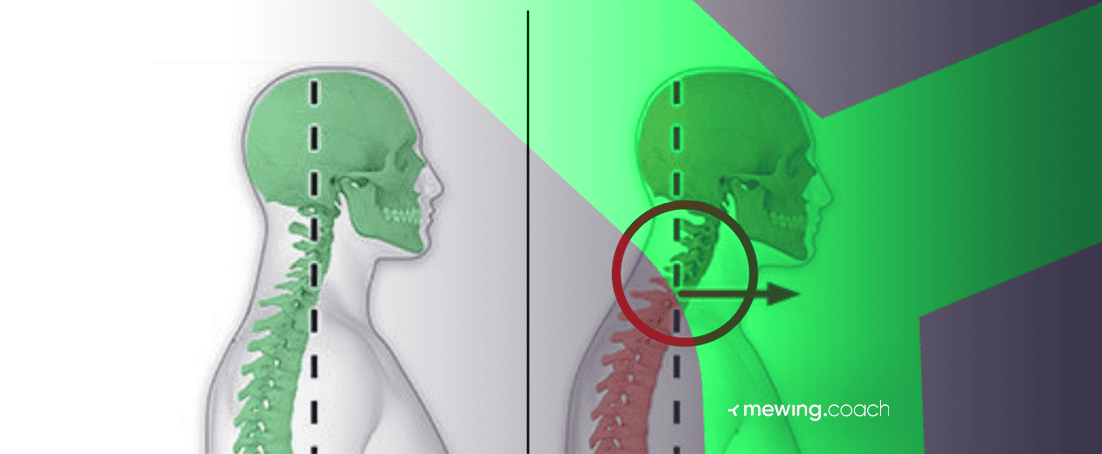Tension in the neck is a common problem in most people that can be caused by poor posture, muscle strain, and other factors. But did you know that you can ease discomfort and achieve neck tension relief and fix forward head posture and nerd neck via mewing practice?
We will teach you how to properly mew by practicing proper tongue posture. This will help you to improve the alignment of the head, neck muscles, and jaw muscles.
Mewing seeks to enhance facial symmetry, eliminate horizontal necklines, increase jawline strength, and address a number of other health concerns by consciously changing how one’s tongue is placed against the roof of the mouth.
So, can you change your face features by mewing? Absolutely, yes. In this article, you’ll read about mewing, and we’ll also walk you through the following:
- 🧾 How mewing can help relieve neck muscles stiffness
- 🔎 Tips for getting started
- 📚 Potential risks and considerations.
Let’s get started!

How Mewing Can Help Relieve Pain in the Neck
John Mew and his son, Dr. Mike Mew, have revolutionized the world of jawline growth, tongue alignment, and face exercises. By practicing mewing, you can strengthen your jaw and facial posture while reducing the discomfort in your neck in a short amount of time. Here, the role of the tongue and facial muscles in keeping proper alignment of the head and neck is crucial.
Mewing affects more than just the face – it also affects the neck, shoulders, and a portion of the spine. Because all parts of the body are interconnected, when one portion gets better, so do the others.
This practice can help you achieve better posture, and, as a result, you will become more conscious of how you carry yourself. Mewing correctly requires sitting up straight, having your feet planted firmly on the ground, and having your knees, hips, and arms in the right positions.
You may also consider mewing to be a type of meditation and physical exercise that is beneficial to your spirituality.
How to Learn to Mew?
As we said, besides neck pain, there are various reasons to start mewing. So, you should know that mewing may help you fight TMJ disorder and other jaw-related issues.
A great way to learn how to mew is by using the Mewing.coach app. It is intended to assist people with a variety of medical problems that impact the face and neck.
Begin by responding to the quiz questions regarding your problems. The information is utilized to create an individualized strategy tailored to your needs, making the Mewing.coach your personal trainer for the successful treatment of your TMJ issues. Also, you will learn how mewing helps with certain headaches! So, the health benefits of using the app are endless.
Tips for Getting Started with Mewing
To begin practicing mewing, think of it as a workout of your face. You would become stronger and develop more defined muscles if you trained for an hour every day for a year.
A healthy tongue posture can prevent numerous health concerns, and it’s crucial to learn how to properly rest the tongue when mewing in the optimal position since it can fix many health issues. Therefore, if a regular workout can alter how the body looks, it also has to be capable of changing how the face looks. Now, let’s see the step-by-step methods of how to get started:
- Step 1: Around half an inch distant from the front teeth, the tongue is raised and softly pressed on the roof of your mouth.
- Step 2: The back portion of the tongue touches the roof as well, although it does not obstruct the airway.
- Step 3: The lips are locked, and the teeth are not touching and are widely apart.
- Step 4: Breathing happens through the nose.
Now that you know how to engage in these tongue exercises, in addition to improving facial structure, you can also improve speaking issues, sleep apnea, breathing difficulties, swallowing difficulties, sinus infections, etc.
Mewing shouldn’t create any pain, but it should make you feel a slight pressure on your face. Avoid mouth breathing, and attempt to breathe as much as you can via your nose. Keep your mouth relaxed and shut.
Numerous factors affect how quickly this method takes effect, such as:
- The natural position of your tongue
- How regularly you use your mouth to breathe
- How long you can maintain a good posture of your tongue
- Whether you are using a limited strategy or a thorough one.
Include It Into Your Daily Routine
It is advised that you add mewing into your daily routine to experience its benefits. This practice is not a quick fix, and individual results may vary. Start mewing slowly, and gradually extend the sessions to make the process easier.
You can check out our Mewing.coach app if you’re new to the game and need some direction to get started. The app provides some useful features, including:
- Exercises and appropriate technique demonstrations in videos
- Up-to-date and detailed educational materials to increase your understanding
- Daily reminders to keep you on track, among other things!
Potential Risks and Considerations
Many people that start mewing complain about mewing and pain of jaw muscles. Know that when you think mewing is causing pain, it means that you are mewing improperly.
Unfortunately, incorrect mewing can result in jaw pain, and you need to be aware of this in order to avoid it. If you have a forward head posture, you are more likely to make mistakes while mewing since it can be challenging for you to maintain the correct tongue posture due to your natural posture.
Mewing can be a very effective practice, so it’s best to correct your mewing posture right away to experience steady results. Make sure you’re chewing, breathing, and drinking properly. However, we would like to stress the fact that you should not use it as a replacement for traditional medical treatment in some cases.
Does Mewing Cause Neck Pain?
It’s crucial to be aware of the circumstances in which mewing neck discomfort could appear. Some minor errors you could be making include not applying the proper tongue posture, exerting excessive force during mewing, leaning your head forward, and having certain medical disorders, including bruxism and larger front teeth.
If you notice mewing neck pain, it is best to stick to the initial technique until you get a grasp of how it’s properly done before moving on to the technique of hard mewing. You may also want to really emphasize your efforts to fix forward head posture. Remember – pushing too hard with your tongue (hard mewing) may cause pain in the jaw or neck.
Conclusion
Are you wondering what changes you can expect from mewing? We can assure you that with patience, consistency, and daily practice, mewing can relieve tension, fix nerd neck, fill hollow cheeks, improve forward head posture, and reduce pain in the neck.
And the best thing is that it does all this while strengthening your jaw and facial posture, as well as fixing rounded shoulders! Here, the tongue muscles and facial muscles play a critical part in maintaining the right alignment of the head and neck.
Hence, we recommend using our Mewing.coach program, where you have everything you need to make it a daily ritual, which is the most effective approach to establishing mewing as a habit. You will discover a thorough tutorial on how to mew properly, how to breathe and swallow while mewing, and what you should avoid.
Remember – you should visit a doctor if you notice that the tension and pain in your neck don’t go away despite rest and at-home remedies.




